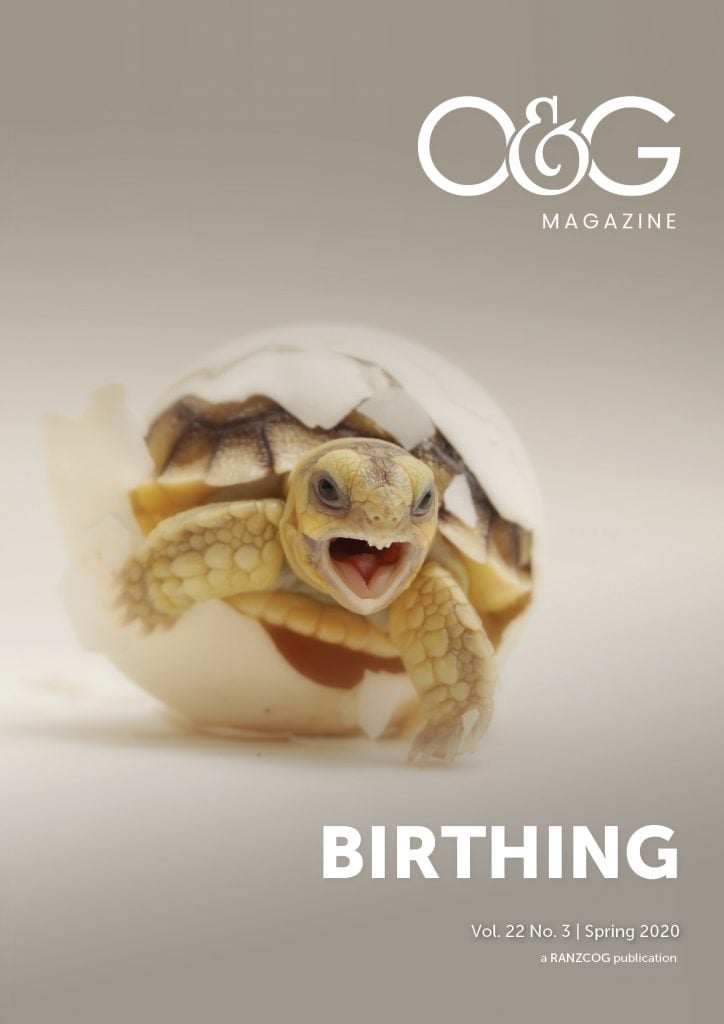In 2012, a conversation resulted between three experienced Fellows and RANZCOG examiners (Stephen Robson, Henry Murray, John Svigos) in response to the perception of negative social and questionable scientific information discouraging women from choosing assisted vaginal birth as a safe delivery option.1 The loss of choice for women was accompanied by an increased caesarean section (CS) rate that had developed without any tangible improvement in perinatal outcomes, along with an increase in short term and ‘down the stream’ maternal morbidity as a result.2 A number of clinicians expressed the view that these changes reflected a loss of confidence in the teaching and training of the next generation of obstetricians to be able to provide assisted vaginal birth as a legitimate option for women.3
The inaugural Birth Master Class (BMC) Workshop was organised at the 2012 Canberra RANZCOG Annual Scientific Meeting as an attempt to halt this process from becoming a self-fulfilling prophecy. That workshop (and the subsequent 10 BMC Workshops) comprised a multi-disciplinary, experienced and enthusiastic faculty (senior obstetricians, midwives, anaesthetist and neonatologist) in tune with contemporary perinatal practice.
To date, a total of 226 consultant obstetricians, senior RANZCOG trainees, GP obstetricians and rural and remote practitioners have undergone a day-long workshop of training in selected vaginal breech delivery, vaginal delivery of selected twins, instrumental vaginal birth and associated procedures required to give them the confidence to provide women with the choice of a safe assisted vaginal birth.
This paper will concentrate on the performance of an instrumental vaginal birth as a safe choice for women.
While traditional guidelines and protocols may identify who may be suitable for instrumental birth, the technical skills to assess labour dystocia accurately and then execute a safe instrumental delivery are slowly mastered over a period of time under the guidance of experienced clinicians.
Ancillary comments and explanation of the nuances, both general and specific, of instrumental vaginal birth in this paper will confirm that the ‘art of obstetrics’ is able to be mastered by obstetricians in training to allow women to have a choice and is a practice encouraged by reputable colleges (including RANZCOG, ACOG and RCOG) with vacuum and forceps assisted vaginal birth both accounting for approximately 11% of births in Australia and just under 10% of births in New Zealand, with the rise in CS in the last decade mirroring the fall in instrumental vaginal birth.4
A judicious obstetrician consulted to consider an instrumental delivery will conduct a clinical assessment of both the mother and the fetus, reviewing the core information in order to determine why an assisted delivery is being considered and how much time is available to effect the delivery.
If the situation is solely delayed progress in the second stage of labour then there may be time to consider the options for the mode of delivery in order to allow discussion of these options at length with the parents and attending staff and obtain an informed consent.
Whereas the discussion time with suspected fetal compromise may be abbreviated to what is likely to be successful and safe for the mother and baby.
Over the last decade, traditional patterns of the progress of labour have received intense scrutiny as a contributor to the increased CS delivery rate due to labour dystocia with the design and adoption of new labour curves of progress and accompanying management guidelines,5 which in turn led to an acceptance of an increased duration of labour compared to that seen under the traditional guidelines.
After the anticipated initial modest fall (not consistently achieved) in the CS delivery rate to justify the change, this potential advantage has not been sustained and we have now been left with a hybrid version of the traditional and new systems of labour assessment and management.6
This failed strategy is not all that surprising as the CS delivery rate rose most rapidly during the decades when there was no change in traditional labour curves or in the guidelines for their interpretation.
With regard to instrumental vaginal birth, there has been a similar recalibration of the traditional second stage of labour duration, modified by the presence of neuro-axial analgesia, to almost physically impossible limits (primigravid woman pushing for three hours) in the hope that a normal vaginal delivery might be achieved.
This form of management was modified to incorporate a policy of ‘delayed pushing’ in the second stage, usually after the demoralising prospect of a woman in labour allowing her previously ‘morale-saving’ epidural to wear off.7
This practice, as with the other strategies mentioned, has been accompanied with increased maternal morbidity, not only from the prolonged duration of labour particularly in the second stage, but also from attempts to deliver the baby either vaginally by instrumental birth under unfavourable circumstances or by CS with the fetal head often deep in the pelvis in the occiput-posterior position with a concomitant increase in neonatal and maternal morbidity.8
How can we make/how have we made an instrumental vaginal delivery a safe choice for women to consider?
Astute management of the first stage of labour with early attention to dystocia will reduce the urgency and duration (in the absence of fetal compromise) of the management of the second stage of labour with encouragement of an active, rather than a passive, management style with timely assistance.
In the case of manual rotation as a strategy to deal with malposition (occiput transverse, occiput posterior) detected late in labour,9 this incompletely evaluated strategy, in order to be successful, requires early assistance at 8–9cm of cervical dilatation and early in the second stage as the procedure becomes more difficult to perform, or even potentially hazardous to the fetus, if its institution is delayed.
For those practitioners not confident to use Kielland’s forceps to deal with fetal malposition in the second stage, a compromise may be achieved by early manual rotation and application of the ventouse (preferably the Kiwi cup), but this will not cover all situations, particularly in the face of a premature infant less than 34–35 weeks or if there is caput and moulding already present, which may interfere with the development of an effective chignon to aid in autorotation that may be required.
In contemporary perinatal centres there has been of late a positive re-evaluation of the benefits of Kielland’s forceps rotation in the situation of a fetal malposition deep in the pelvis at full dilation of the cervix.10
A number of critical strategies have evolved to assist with this re-evaluation of the use of Kielland’s forceps and these include the involvement of a committed anaesthetist for the analgesia/anaesthesia requirements of patients in labour ward with an effective epidural, pelvic floor relaxation and timely episiotomy being fundamental to the execution of a safe rotational vaginal delivery with forceps.
Theatre management has changed favourably to now allow the provision of a trial of instrumental birth with the propensity to move to CS, if necessary, as part of contemporary obstetric practice.
Failed instrumental vaginal delivery with potential neonatal morbidity has been addressed by the development of strategies to deal with the impacted fetal head at CS with the use of the Fetal Pillow, the conduct of the CS in the modified lithotomy position and simulation training of obstetricians with ‘Desperate Debra’ to develop strategies for dis-impaction including the ‘Push’ and ‘Pull’ techniques.11
A nested study by the BMC Faculty of 40 senior RANZCOG registrars who undertook the Workshop with a two year follow-up has found that of those who returned to an institution where the use of Kielland’s forceps was encouraged, all continued with the practice while not surprisingly those returning to an institution where the practice was not encouraged, only 25% continued with the practice.
With babies in the occiput-anterior position requiring delivery in the second stage due to the traditional indications of fetal compromise, failure to progress and malposition, along with the fulfilment of the requirements for instrumental vaginal birth, including consideration of pudendal nerve block anaesthesia, then apart from perhaps requiring further assistance with the determination of fetal position by ultrasound,12 the choice for the obstetrician is that of which instrument to use, with ventouse being promoted as being less traumatic to the mother and Simpson’s pattern forceps being less traumatic to the fetus. The obstetrician’s preference is usually predominating, but possibly modified by, the presence of adequate analgesia and/or fetal compromise.
As with any instrumental birth, a discerning obstetrician would anticipate the possibility of concomitant shoulder dystocia, postpartum haemorrhage and the potential need for neonatal resuscitation, and be prepared for such contingencies in order to ensure a safe delivery option for women.
The BMC Workshop may give confidence to obstetricians to provide women with the choice of a safe instrumental vaginal birth. Apart from timely practice revision, the workshop can provide the initial positive learning experience, but reinforcement of this experience is dependent on continued practice and supervision by experienced clinicians ensuring that not only are the instrumental techniques performed correctly but that the required associated skills to mitigate potential complications are taught and encouraged along with debrief, audit and credentialing being integral to the process.
Hence, to answer the original question: yes, women may take the choice of a safe instrumental vaginal birth.
Acknowledgements
The authors wish to acknowledge the unqualified support of Tania Back and the RANZCOG SA&NT Regional Committee.
References
- Merriam AA, Ananth CV, Wright JD et al. Trends in operative vaginal delivery, 2005 – 2013: a population-based study. BJOG. 2017;124:1365-72.
- Goetzinger KR, Macones GA. Operative vaginal delivery: current trends in obstetrics. Women’s Health. 2008;4(3):281-90.
- Bailey PE. The disappearing art of instrumental delivery: Time to reverse the trend. Int J Gynecol Obstet. 2005;91(1):89-96.
- RANZCOG. Instrumental Vaginal Birth. C-Obs-16. 2019. Available from: https://ranzcog.edu.au/statements-guidelines/obstetrics/instrumental-vaginal-birth-(c-obs-16)
- Zhang J, Landy HJ, Reddy UM. Contemporary Patterns of Spontaneous Labor with Normal Neonatal Outcomes. Obstet Gynecol. 2010;116(6):1281-7.
- Cohen WR, Friedman EA. Guidelines for labor assessment: failure to progress? Am J Obstet Gynecol. 2020;222(4):342.e1-342.e4.
- Di Mascio D, Saccone G, Bellussi F, et al. Delayed versus immediate pushing in the second stage of labor in women with neuraxial analgesia: a systematic review and meta-analysis of randomised controlled trials. Am J Obstet Gynecol. 2020. doi: 10.1016/j.ajog.2020.02.002.
- Laughon SK, Bergella V, Reddy UM, et al. Neonatal and Maternal Outcomes with Prolonged Second Stage of Labor. Obstet Gynecol. 2014;124(1):57-67.
- Le Ray C, Serres P, Schmitz T, et al. Manual rotation in occiput posterior or transverse positions. Obstet Gynecol. 2007;110(4):873-9.
- Stock SJ, Joseph K, Farquharson S, et al. Maternal and neonatal outcomes of successful Kielland’s rotational forceps delivery. Obstet Gynecol. 2013;121(5):1032-9.
- Manning JR, Tolcher MC, Chandraharan E, Rose CH. Delivery of an Impacted Fetal Head During Caesarean: A Literature Review and Proposed Management Algorithm. Obstet Gynecol Survey. 2015;70(11):719-24.
- Akmal S, Kametas N, Tsoi E, et al. Comparison of transvaginal digital examination with intrapartum sonography to determine fetal head position before instrumental delivery. Ultrasound Obstet Gynecol. 2003;21(5)103.








Leave a Reply